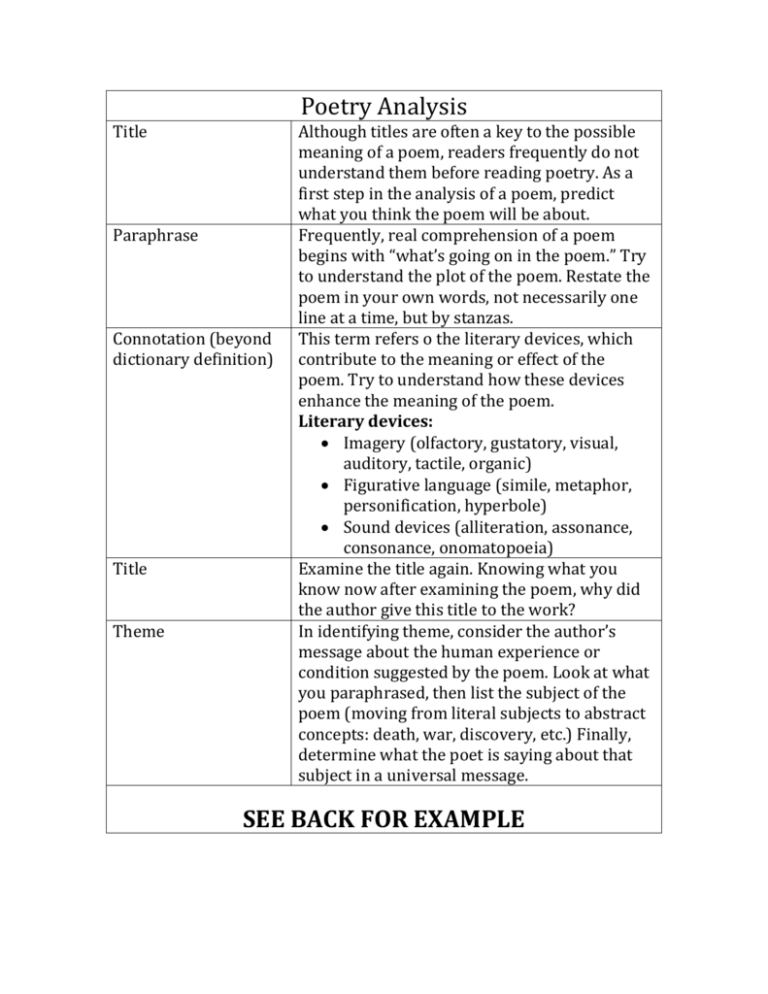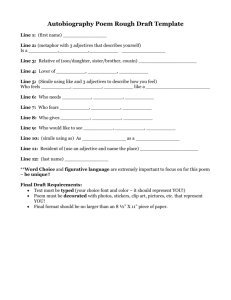Poem Analysis exemplar
advertisement

Poetry Analysis Title Paraphrase Connotation (beyond dictionary definition) Title Theme Although titles are often a key to the possible meaning of a poem, readers frequently do not understand them before reading poetry. As a first step in the analysis of a poem, predict what you think the poem will be about. Frequently, real comprehension of a poem begins with “what’s going on in the poem.” Try to understand the plot of the poem. Restate the poem in your own words, not necessarily one line at a time, but by stanzas. This term refers o the literary devices, which contribute to the meaning or effect of the poem. Try to understand how these devices enhance the meaning of the poem. Literary devices: Imagery (olfactory, gustatory, visual, auditory, tactile, organic) Figurative language (simile, metaphor, personification, hyperbole) Sound devices (alliteration, assonance, consonance, onomatopoeia) Examine the title again. Knowing what you know now after examining the poem, why did the author give this title to the work? In identifying theme, consider the author’s message about the human experience or condition suggested by the poem. Look at what you paraphrased, then list the subject of the poem (moving from literal subjects to abstract concepts: death, war, discovery, etc.) Finally, determine what the poet is saying about that subject in a universal message. SEE BACK FOR EXAMPLE Mother to Son Title Paraphrase Connotation (beyond dictionary definition) Title Theme By Langston Hughes This poem may be a mother giving advice to her son. The mother is describing her life to her son telling him to never give up. Literary devices: Imagery: tactile-“tacks” “splinters” Figurative language: metaphor- the stairs are being compared to life Sound devices: consonance-repetition of the “n” sound: “climbin” “reachin” “landin” “turnin” “goin” The poet used literary devices to convey the mother’s advice to her son The poem shows the reader through literary devices such as figurative language and imagery that the mother has had a hard life and is “telling” her son to never “sit down.” The crystal stairs is the exact opposite of the mother’s experiences. The crystal stairs represent prestige and money SEE BACK FOR EXAMPLE Paragraph exemplar: Poets use many literary devices to convey a theme to the readers. In the poem “Mother to Son” by Langston Hughes, imagery, figurative language, and sound devices are used to express the speaker’s experiences. The crystal stairs are a metaphor comparing to the speaker’s life. Tactile imagery is used to describe the stairs with “tacks” and “splinters.” These devices suggest the mother did not have prestige and money and the speaker tells her son “life for me ain’t been no crystal stair” suggesting that she has endured many hardships.







